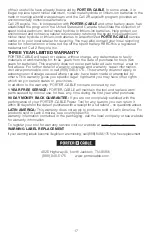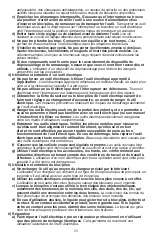
5
• Use the tool only for its intended use. Do not discharge
fasteners into open air, concrete, stone, extremely hard
woods, knots or any material too hard for the fastener to
penetrate.
Do not use the body of the tool as a hammer.
Discharged fasteners may follow unexpected path and
cause injury.
(Figs. 4, 5, 6)
• Refer to the
Maintenance
and
Repairs
sections for detailed
information on the proper maintenance of the tool.
• Always operate the tool in a clean, lighted area.
Be sure
the work surface is clear of any debris and be careful not to
lose footing when working in elevated environments such as
rooftops.
• Do not drive fasteners near edge of material. The workpiece
may split causing the fastener to ricochet, injuring you or a
co-worker. Be aware that the nail may follow the grain of the
wood (shiner), causing it to protrude unexpectedly from the
side of the work material. Drive the chisel point of the nail
perpendicular to the grain to reduce risk of injury. (Figs. 5, 6, 11)
•
Do not drive nails onto the heads of other fasteners or
with the tool at too steep an angle.
Personal injury from
strong recoil, jammed fasteners, or ricocheted nails may
result. (Fig. 7)
• Always keep fingers clear of contact trip to prevent injury
from inadvertent release of the pusher (Fig. 8)
• Keep hands and body parts clear of immediate work area.
Hold workpiece with clamps when necessary to keep hands
and body out of potential harm. Be sure the workpiece is
properly secured before pressing the nailer against the
material. The contact trip may cause the work material to shift
unexpectedly. (Fig. 8)
• Do not use tool in the presence of flammable dust, gases or
fumes. The tool may produce a spark that could ignite gases
causing a fire. Driving a nail into another nail may also cause a
spark. (Fig. 9)
• Keep face and body parts away from back of the tool when
working in restricted areas. Sudden recoil can result in impact
to the body, especially when nailing into hard or dense
material. (Fig. 10)
•
Grip tool firmly to maintain control while allowing tool to
recoil away from work surface as fastener is driven.
• Choice of triggering method is important.
Check the manual
for triggering options.
• When actuating the finishing nailer, always keep tool in control.
Inaccurate placement of tool can result in misdirected discharge
of a fastener.
• Do not drive nails onto the heads of other fasteners. Strong recoil,
jammed fasteners, or ricocheted nails may result. (Fig. 11)
• Be aware of material thickness when using nailer. A protruding
nail may cause injury.
FIG. 8
FIG. 7
FIG. 9
FIG. 10
FIG.4
FIG. 5
FIG. 6
Содержание PCC792
Страница 55: ...55...
Страница 56: ...56 Catalog Numbers PCC792 Form 90631744 rev01 January 2016 Printed in China...




































